 Website:
UWT GmbH
Website:
UWT GmbH
Group: UWT-Group
Catalog excerpts

SOLUTIONS FOR TRICKY LEVEL MEASUREMENT CHALLENGES When it gets tricky! WHITE PAPER M ULTITALENT TDR IN S OLIDS & LIQUIDS Nikolas Oppenberger Product Management
Open the catalog to page 1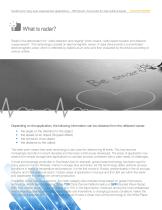
Solutions for tricky level measurement applications – TDR Sensor: All-rounder for bulk solids & liquids WHITE PAPER What is radar? Radar is the abbreviation for "radio detection and ranging" which means "radio-based location and distance measurement". This technology is based on electromagnetic waves. A radar device emits a concentrated electromagnetic wave, which is reflected by objects as an echo and then evaluated by the device according to various criteria. Depending on the application, the following information can be obtained from the reflected waves: the angle or the...
Open the catalog to page 2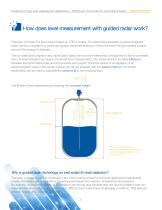
Solutions for tricky level measurement applications – TDR Sensor: All-rounder for bulk solids & liquids WHITE PAPER How does level measurement with guided radar work? The basic principle of a level sensor based on TDR is simple. The electronics generate an electromagnetic pulse, which is coupled to a probe and guided downwards along it. When the wave hits the material surface, some of the energy is reflected. This so-called echo signal is also routed back along the rod to the electronics, recognized by it and converted into a fill level indication by means of a transit time measurement. The...
Open the catalog to page 3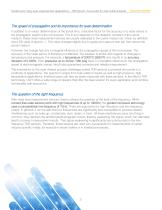
Solutions for tricky level measurement applications – TDR Sensor: All-rounder for bulk solids & liquids WHITE PAPER The speed of propagation and its importance for level determination In addition to an exact determination of the transit time, a decisive factor for the accuracy of a radar sensor is the propagation speed of the microwaves. This in turn depends on the dielectric constant of the carrier medium. Radar level measurement devices are usually calibrated in the carrier medium air, which by definition has a DK value of approx. 1. This value changes slightly due to gases and vapours...
Open the catalog to page 4
Solutions for tricky level measurement applications - TDR Sensor: All-rounder for bulk solids & liquids WHITE PAPER Solutions for tricky level measurement applications - TDR Sensor: All-rounder for bulk solids & liquids WHITE PAPER How do TDR sensors master the challenges of bulk solids applications? There are many challenges in the bulk goods sector. High, narrow silos and large measuring distances, pouring cones, build-up, dust, materials with low DK values and high mechanical tensile forces pose particular challenges for measuring technology. TDR sensors prove to be true all-round...
Open the catalog to page 5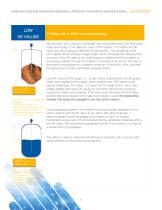
Solutions for tricky level measurement applications - TDR Sensor: All-rounder for bulk solids & liquids WHITE PAPER Solutions for tricky level measurement applications - TDR Sensor: All-rounder for bulk solids & liquids WHITE PAPER The echo curve for media with low DK value. Characteristic are the lower amplitude of the echo signal and a signal propagation through the medium with a negative downturn at the end of the probe. If things are a Httfe more demanding... One question one is always confronted with when determining the level using radar technology is the dielectric value of the...
Open the catalog to page 6
Solutions for tricky level measurement applications – TDR Sensor: All-rounder for bulk solids & liquids WHITE PAPER If something gets lost… If you compare the echo curves of an empty and a full container, there is a second difference in addition to the amplitude of the level echo. The signal of the probe end appears farther away with a container filled with material than with empty containers. This shows the dependence on the speed of propagation and the carrier medium. While the microwave can always spread out in the free space in the empty container to the end of the probe, it must...
Open the catalog to page 7
Solutions for tricky level measurement applications – TDR Sensor: All-rounder for bulk solids & liquids BULK CONE WHITE PAPER If things are a little steeper... Bulk cones are a well-known phenomenon in bulk solids applications. They form in the course of filling and emptying processes. Due to the conical surface shape, signal loss and measurement errors can occur. Here TDR sensors offer a decisive advantage. Since the microwaves are guided along the probe, signal loss due to signals reflecting away is eliminated. This also simplifies echo analysis. In addition, due to the low frequency, the...
Open the catalog to page 8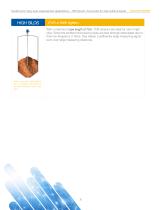
Solutions for tricky level measurement applications – TDR Sensor: All-rounder for bulk solids & liquids HIGH SILOS WHITE PAPER If it's a little higher... If it's a little higher... With a maximum rope length of 75m, TDR sensors are ideal for use in high silos. Since the emitted microwave pulses are less strongly attenuated due to their low frequency (1 GHz), they deliver a sufficiently large measuring signal even over large measuring distances. With a maximum rope length of up to 75 meters, TDR sensors are also suitable for use in high silos
Open the catalog to page 9
Solutions for tricky level measurement applications – TDR Sensor: All-rounder for bulk solids & liquids WHITE PAPER Exemplary application of the TDR in SOLIDS NG 3000 in high storage silo for cement www.uwt.de/tdr-cement-application Special Challenges: dust-intensive process environment material prone to build-up high process compatibili
Open the catalog to page 10
Solutions for tricky level measurement applications – TDR Sensor: All-rounder for bulk solids & liquids WHITE PAPER How do TDR sensors master the challenges in the liquid area? Due to its flexibility, the TDR technology is predestined to be used in liquid applications. Similar to the bulk goods area, measurement technology is also confronted with a variety of challenges, the characteristics of which however differ from those of the solids. Steam, condensate, agitators or heating coils, distinctive separating layers, wave movements, volatile substances or limited space due to smaller...
Open the catalog to page 11
Solutions for tricky level measurement applications – TDR Sensor: All-rounder for bulk solids & liquids NARROW SPACES TDR sensors with coaxial probes are the most reliable type of level determination. A popular type of installation for TDR sensors is the bypass. The effect of the bypass tube is comparable to that of a coaxial tube. Heating spindle inside a tank: No problem for TDR sensors with a coaxial probe. Even coils are not a source of interference with a coaxial probe. WHITE PAPER When things get a little tighter... Achieving a consistently constant process temperature is a...
Open the catalog to page 12All UWT GmbH catalogs and technical brochures
-
NivoRadar ® 7000
2 Pages
-
Highlight NivoRadar® 4000 en
1 Pages
-
NivoCapa® NC 8000
2 Pages
-
Vibranivo® VN 4000
2 Pages
-
Vibranivo® VN 2000 / VN 6000
2 Pages
-
Vibranivo® VN 1000 / VN 5000
2 Pages
-
RFnivo® 8000 Product Leaflet
2 Pages
-
Rotonivo® RN 4000
2 Pages
-
NivoRadar® NR 3000
2 Pages
-
Rotonivo® RN 3000 / 6000
2 Pages
-
Product-Overview UWT new 2023-11
28 Pages
-
NivoGuide® NG 3000
2 Pages
-
NivoBob® NB 4000
2 Pages
-
NivoBob® NB 3000
2 Pages
-
Capanivo® CN 4000
2 Pages
-
Capanivo® CN 8000
2 Pages
-
Solids - Liquids at a glance
2 Pages
-
Radar Flyer Neu 2023 en
2 Pages
-
Solutions for the Grain industry
26 Pages
-
Vibrasil®70/90 Level switch
2 Pages
-
Solutions for the Power Industry
28 Pages
-
Solutions for the Steel Industry
26 Pages
-
Level limit switch VN 4000
14 Pages
-
Level limit switch RN 4000
10 Pages
-
Level limit switch RF 8000
15 Pages
-
Level limit switch RF 3000
25 Pages
-
Level limit switch MN 4000
14 Pages
-
Level limit switch CN 8000
14 Pages
-
Level limit switch CN 4000
13 Pages
-
Level limit switch CN 7000
7 Pages
-
DK value
8 Pages































































